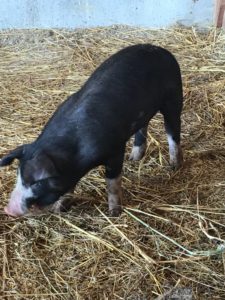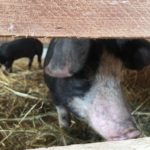
By Gabe Ross, farm manager
Many visitors to Gallant Farm this summer were curious about the little shed on skids outside the big barn, and we told them it was future housing for pigs. It took a little time, but the wait for the hog-shed occupants is over! Two Poland China barrows (male pigs) arrived at the farm on August 14. They were born at Slate Run Living History Farm in Canal Winchester and, in the spirit of sharing resources between living history farms, were donated to Preservation Parks.
The Poland China breed originated in southwestern Ohio in the early to mid-19th century. It was developed using several types, or breeds, of pigs that had been brought with settlers to Ohio. These included Big-China, Irish Grazer, Bedfordshire Pig, Russian Pig and later, Berkshire. Early Poland China pigs were lighter in color or spotted, but in the 1830s with the introduction of the Berkshire into the bloodline, pigs began to get darker. However, some spotted Poland Chinas remain.
The name Poland China began to be used by two farmers in the Miami Valley of Ohio in the 1860s, with “China” being from the Big China breed and “Poland” from the belief that the stock originated from a Polish breed. An investigation was conducted and reported to the National Swine Breeders convention in 1872, and it was found that the pigs had no Polish decent. The name Poland referred to the offspring of a singular animal owned by a Butler County farmer who, himself, was from Poland – but his pigs were not. Nonetheless, the name stuck because it was already widely used.
 At the time the Poland China was bred, the lard type of pig was king. Lard was extremely important for cooking, canning, soap making and a variety of other things. The Poland China was a lard type pig that did well on pasture, which was how hogs were often raised at the time. Today, leaner bacon type breeds are more prevalent and the Poland China pigs of today more closely resemble those. The largest pig ever recorded was “Big Bill” in 1933, a Poland China from Tennessee that weighed 2,552 pounds.
At the time the Poland China was bred, the lard type of pig was king. Lard was extremely important for cooking, canning, soap making and a variety of other things. The Poland China was a lard type pig that did well on pasture, which was how hogs were often raised at the time. Today, leaner bacon type breeds are more prevalent and the Poland China pigs of today more closely resemble those. The largest pig ever recorded was “Big Bill” in 1933, a Poland China from Tennessee that weighed 2,552 pounds.
Pigs were important on Depression Era farms because they could efficiently convert lots of different feed types into not only meat, but also lard that was very useful to farm families. At Gallant Farm, the pigs will be pastured in areas that need renovation to improve them for sheep grazing. After the pigs have rooted up weeds and undesirable plants, clover and grass will be planted. Their shed will be moved every so often to keep the pigs clean and healthy. They will be raised to finishing weight on a mixture of corn grown on the farm, purchased concentrate, and all the kitchen and garden scraps they can handle. We would love to have you come out to Gallant Farm and see the newest additions, which, along with our chickens and sheep, help represent Ohio’s agricultural heritage.







